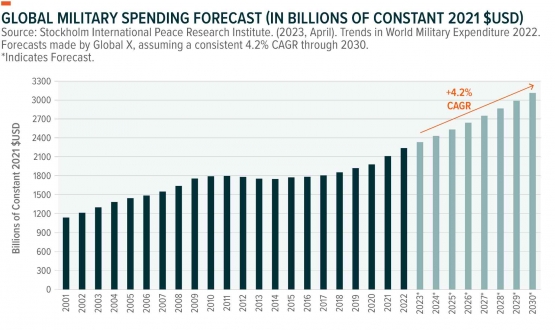4) India
Projections show that India's military spending is expected to reach 183 billion US dollars by 2030. This increase can be attributed to India's continued efforts to modernize its military and maintain the balance of power in the region.
5) South Korea
Projections show that South Korea's military spending is expected to reach 82.4 billion US dollars by 2030. This increase may be due to South Korea's continued efforts to modernize its military and maintain the balance of power in the region.
6) Japan
Projections show that Japan's military spending is expected to reach 62.9 billion US dollars by 2030. This increase can be attributed to Japan's continued efforts to modernize its military and maintain a balance of power in the region.
7) Australia
Projections show that Australia's military spending is expected to reach 44.4 billion US dollars by 2030. This increase may be due to Australia's ongoing efforts to modernize its military and maintain a balance of power in the region.
Asia Power Index 203
According to the Lowy Institute Asia Power Index, several countries are expected to experience significant increases in military spending through 2030. For example, China's military spending is projected to reach 531 billion dollars, India 183 billion dollars, and Russia 123 billion dollars.
These suggest that many countries plan to increase military spending in the next few years. However, these are only predictions and actual expenditures may vary based on a number of factors, including changes in the global security environment, economic conditions and policy decisions. Please note that these predictions are based on currently available data and are subject to change in the future.
Global Trends
V. Conclusion
Global military budget growth reached a new record in 2022, with an increase of 3.7 percent to 2,240 billion US dollars. Projections show that this trend will continue through 2030, with growth in global military and defense spending expected to reach nearly 40 percent. This increase was triggered by geopolitical tensions, technological advances in the modernization of armed forces, and internal security concerns in various countries.
Distrust and Uncertainty Theory reflects the dynamic in which worry and fear between countries can trigger increased military spending. Cycles of arms races and security dilemmas can emerge when one community feels threatened and prepares, prompting similar responses from other communities. As a result, defensive actions initially aimed at self-protection can appear aggressive, while distrust continues to develop.
Empirical data shows significant increases in the military budgets of several countries, such as Finland, Lithuania, Sweden, Poland and Russia. These improvements are largely directed at enhancing national protection capabilities. Nonetheless, military budget projections for several countries, including the United States, United Kingdom, China, India, South Korea, Japan, and Australia, indicate a commitment to increasing military spending in the next few years.
These trends have serious implications, including increasingly aggressive defensive actions, transcription reproduction, and a continuing cycle of mutual distrust between countries. While global military budgets are increasing, the real challenge is how to understand and address the root causes of disease and promote sustainable international security and cooperation. These projections should be understood as estimates that may change based on global conditions, security and policy developments in the future.
VI.References
Institute, Lowy. n.d. “Military Expenditure Forecast 2030 Data - Lowy Institute Asia Power Index.” Lowy Institute Asia Power Index 2020. https://power.lowyinstitute.org/data/future-resources/defence-resources-2030/military-expenditure-forecast-2030/.
Tian, N., Silva, D. L. da, Liang, X., Scarazzato, L., Béraud-Sudreau, L., & Assis, A. (2023, April 1). Trends in World Military Expenditure, 2022. SIPRI. https://www.sipri.org/publications/2023/sipri-fact-sheets/trends-world-military-expenditure-2022






